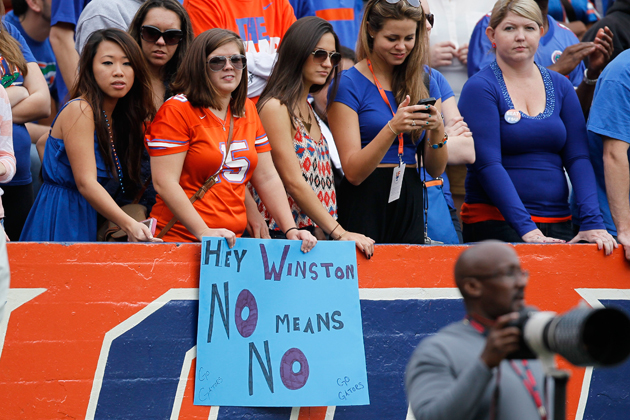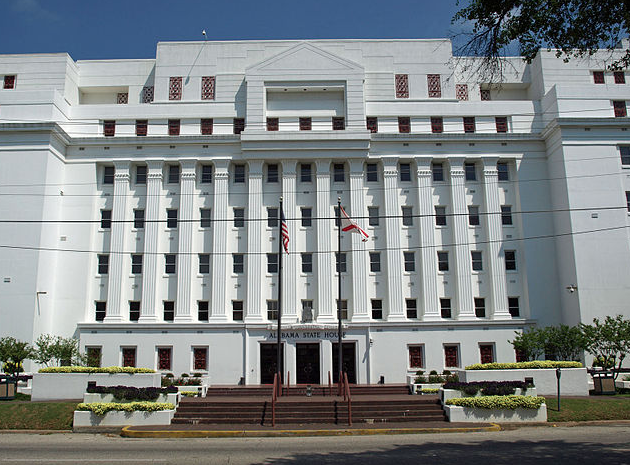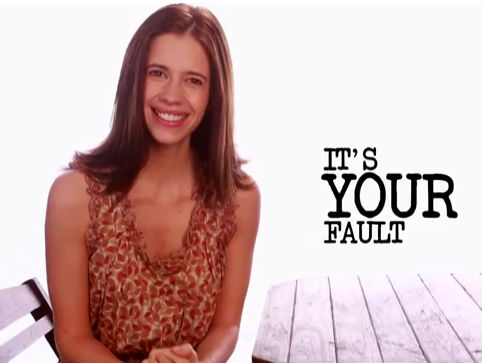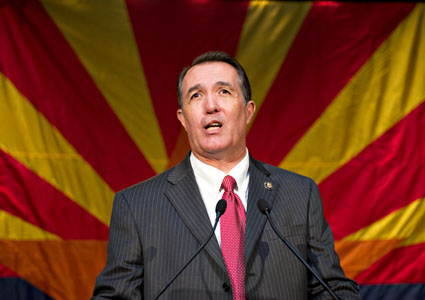
Eve Edelheit/Tampa Bay Times /Zuma
Update: ESPN is reporting that Jameis Winston will not be charged in connection to an alleged sexual assault last December.
In November, TMZ reported that a former Florida State University student had accused the school’s quarterback, Jameis Winston, of rape nearly a year ago. The accuser’s lawyer says that after she came forward the Tallahassee police tried to dissuade her from pressing charges, warning her that the city is “a big football town” that might not treat her warmly if she leveled these allegations. Indeed, since her charges became public, some Seminoles fans have floated conspiracy theories that a rival school or Heisman Trophy contender may have put the accuser up to it. Prosecutors, for their part, will hold a press conference on Thursday afternoon to announce whether they’ll go forward with the case.
Ultimately, Winston—whose DNA was found at the scene and who claims the sex was consensual—may not be charged. But the case has highlighted a disturbing and long-standing pattern in college football. At top football schools the sport is a major moneymaker, and many big-name universities (and law enforcement authorities in those jurisdictions) have too often shielded players accused of rape—even going so far as to smear and punish victims who speak out. Here’s a brief guide to college football’s sordid history of addressing sexual assault:
University of Notre Dame, 1974: An undergraduate accused six Fighting Irish players of rape. A university administrator called the woman, who later spent a month in psychiatric care, a “queen of the slums with a mattress tied to her back.” No charges were filed.
Notre Dame, 1976: Two of the Notre Dame players accused in 1974, along with one other player, were accused of rape by a 17-year-old student. “I was told to shut up and mind my own business,” a witness to the assault later told the National Catholic Reporter‘s Melinda Henneberger. The witness, a resident advisor at nearby St. Mary’s College, had been informed by administrators that one of the players had been involved in another unreported rape, in addition to the previous 1974 incident. No charges were filed.
University of Colorado, 1989: Twenty-four Buffaloes were arrested in a three-year span under coach Bill McCartney for everything from rape to illegally skinning a rabbit. Another former player, linebacker Miles Kusayanagi, was accused of being “the Duct-Tape Rapist,” responsible for eight sexual assaults in Boulder. (He was convicted on four counts of first-degree sexual assault.) McCartney told a local news reporter that another alleged rape by one of his players couldn’t have been rape because it wasn’t violent enough. Besides, he told Sports Illustrated, it could be worse: “You’ll notice that we haven’t had anybody shoot anybody.”
University of Oklahoma, 1989: Three players were arrested and two convicted of raping a female student in a dorm room. Nigel Clay, one of the two players convicted of rape, told the Los Angeles Times in 1992: “Well, speaking for myself and a lot of other people, we felt like we were above the law…like OU would protect us from anything.” Head coach Barry Switzer resigned, but was hired six years later as head coach of the Dallas Cowboys.
University of Nebraska, 1993: Defensive lineman Christian Peter’s punishment for being convicted of third-degree sexual assault? He was put on probation and missed one exhibition game. Peter, a future NFL draft pick, was accused by two other women of sexual assault during his time on campus and arrested a total of eight times for a range of offenses. Kathy Redmond, one of Peter’s accusers, received threatening phone calls and had her car vandalized for reporting the assault. (Peter’s teammate, Lawrence Phillips, was suspended for physically assaulting his girlfriend, but was reinstated by Cornhuskers head coach Tom Osborne in time to play in the 1995 national title game.) Osborne went on to serve three terms in Congress. Peter was inducted into the Nebraska Football Hall of Fame in 2006.
Florida State, 1994: Kicker Scott Bentley was sentenced to 40 hours of community service for illegally recording a woman having sex. “This should serve as a clear message to our football players that this behavior and mistreatment of women will not be tolerated,” said head coach Bobby Bowden, upon announcing that Bentley would be suspended for the summer but keep his scholarship and miss no games. Within a two-week period that spring, a Seminoles running back was accused of exposing himself to a woman while walking across campus, and a tight end was charged with rape (for which he was acquitted).
Virginia Tech, 1994: Freshman Christy Brzonkala ran into a wall of obstruction when she told administrators she had been raped by two Virginia Tech football players. The school, which was investigating her claims, dropped charges against one player after he threatened to sue because the school’s code of conduct did not explicitly forbid sexual assault. His only penalty was a “one-hour educational session”—with the accuser. The other player was suspended for a year—only to have the suspension dropped before football season started. A campus spokeswoman publicly chided Brzonkala (who transferred) for coming forward six months after the incident. She sued the school under the Violence Against Women Act, only to see the relevant portion of the law struck down in federal court.
Idaho State University, 1995: Four Bengals football players were sentenced to community service and one-year of probation for statutory rape.
Appalachian State University, 1997: A female student alleged she had been raped by six football players, but the school’s judicial board downgraded their offenses to “lewd conduct.” One player was suspended from school; one was cleared; and the rest were placed on probation, allowing them to eventually return to the football team. ASU Chancellor Francis Borkowski’s message to students that year: “If you are not in control of your life through indulgence in alcohol and drugs, then you are setting yourself up.”
Colorado, 1997: No charges were filed by Boulder police after a woman alleged she was raped by a football recruit at a party, because witnesses were deemed too inebriated to be trustworthy. Boulder district attorney Mary Keenan later told the New York Times the incident was a consequence of ”an ugly football subculture.”
Louisiana State University, 1998: Star running back Cecil Collins was dismissed from the team after being accused of two sexual assaults in two weeks (the first was of a minor). He was sentenced to probation. That didn’t stop another football program, McNeese State, from offering him a full scholarship, or the Miami Dolphins from drafting him. “Charming and likable, he has, nonetheless, seen his collegiate football career derailed by sexual assault charges and failed drug tests,” the Sun-Sentinel reported in 1999. His career ended in 2001, when he was convicted of breaking into a woman’s home to watch her sleep.
Oklahoma State University, 1999: Stillwater police asked a female student who accused four football players of rape to immediately sign a form stating that she would not press charges—just hours after coming forward. She filed a federal lawsuit two years later, eventually settling with the players, two of whom went on to play in the NFL.
United States Naval Academy, 2000: Three football players were accused of raping a female midshipman who passed out at an off-campus party. They avoided prosecution in exchange for leaving the academy.
University of Florida, 2000: Offensive line recruit Jason Respert was accused of breaking into a female student’s bedroom and sexually assaulting her, but the charges were reduced to trespassing and simple battery. He did 40 hours of community service and went on to accept a full scholarship at the University of Tennessee.
Colorado, 2001: A female student alleged she was raped repeatedly by Buffaloes football players at an off-campus party for recruits. “It certainly is not the best timing,” said a school vice president, noting that the team was trying to prepare for the Tostitos Fiesta Bowl. Others blamed the victim. “There is also no question in my mind that the behavior of the 10 young people involved was the result of their own poor decisions under the influence of alcohol,” head coach Gary Barnett said later—alluding to not just the football players and their recruits, but the three alleged victims.
University of Washington, 2001: After accusing a Huskies star of rape, university officials suggested that a female student sit down for one-on-one mediation with her alleged rapist instead of calling the cops. Although a jury later ruled in the school’s favor three years later, its members had harsh words for school administrators in interviews with the Seattle Times. “When asked Thursday how the UW handled the case, one juror said: ‘You want a quote? Piss poorly.'”
Notre Dame, 2002: A female student alleged that she was raped by three football players and one former member of the team. All were eventually expelled, but not before the school tried to dissuade the victim from pressing charges and prevented her from receiving counseling, according to the National Catholic Reporter. Safety Abram Elam, who served no prison time after being convicted of sexual battery, later enrolled at Kent State and went on to a seven-year career in the NFL.
Colorado, 2004: After former kicker Katie Hnida told Sports Illustrated she was repeatedly sexually assaulted by teammates, head coach Gary Barnett said she was sore about her shortcomings as a football player: “It was obvious Katie was not very good. She was awful. You know what guys do? They respect your ability. You can be 90 years old, but if you can go out and play, they’ll respect you. Katie was not only a girl, she was terrible. OK? There’s no other way to say it. She couldn’t kick the ball through the uprights.” In another incident, a female student told police that Barnett threatened to support his player “100 percent” if she came forward with her rape allegation. Barnett was briefly suspended, but returned to the team for another season. He was fired at the end of the 2005 season—for ending the season on a three-game losing streak. He took a $3 million buyout.
Brigham Young University, 2004: Four players were indicted and two players sent to trial in the gang rape of a fellow student. Although a teammate testified against them at the trial, the players were acquitted. In The System: The Glory and Scandal of College Football, Jeff Benedict and Armen Keteyian offered one reason why: “After the courtroom cleared out, three jurors were still around. Kelly [the prosecuting attorney] cornered them and asked why they had acquitted. ‘The jury said they had suffered enough,’ Kelly said. ‘They lost their scholarships. They were kicked off the team.’ Kelly said it was the most bizarre thing she’d ever heard—the idea that the players had been sufficiently punished when they lost their opportunity to play football. ‘That’s the power of college football,’ she said.”
Arizona State University, 2004: A female student working as a tutor for a summer program for football students sent an email to her supervisors about a freshman recruit: “I don’t want to get raped in college and that is what Darnel [Henderson] makes me feel like when he is around me.” By the end of the summer, ESPN reported, Henderson had been accused of sexually assaulting women in his dorm and exposing himself to female staffers. When confronted, his response was to tell a staff member that he felt he had to “show [women] their place.” The university’s response was to bow to head coach Dirk Koetter’s request that Henderson keep his scholarship. When Henderson was accused of rape by a different student a year later, ASU police mysteriously waited three weeks to interview him despite deciding internally that Henderson was probably guilty. A university administrator accompanied Henderson to his meeting with investigators, and when the case was submitted to Maricopa County, the district attorney declined to pursue the case. ASU administrators, meanwhile, tried to destroy incriminating evidence—like the fearful email. Koetter, who sought to get Henderson a scholarship to another top-tier college football program, was fired two years later because he couldn’t consistently beat top-25 opponents.
University of Tennessee-Chattanooga, 2005: Six Mocs football players were charged with raping a student. But head coach Rodney Allison let the players take the field against West Carolina University before informing Chancellor Roger Brown the players would be suspended. Brown said he was told the players had broken curfew. The charges were eventually thrown out.
University of Montana, 2010: Public records revealed that top administrators sought to cover up allegations that four football players had raped a female student. Vice President James Foley tried to punish the accuser under the school’s code of conduct and instructed colleagues to refer to the incident as a “date rape” instead of a “gang rape.” In separate incidents, a star quarterback and running back were both accused of rape. (The running back was later convicted; the quarterback continued practicing with the team after being charged, but was found not guilty.*) Athletic Director Jim O’Day showed reporters photos of a woman who had been bit by a star cornerback accused of sexual assault in an attempt to show them that it wasn’t that bad. He was ultimately terminated with a full year’s pay.
Notre Dame, 2010: “Messing with Notre Dame football is a bad idea,” a friend of a football player texted Lizzy Seeberg, after she accused a Fighting Irish player of rape. Shortly thereafter, Seeberg took her life. The university president refused to meet with Seeberg’s family after her death and school officials tried to smear her in the press. Another woman, who was taken to the hospital for a rape exam later that year, declined to file a complaint after receiving threatening texts from Notre Dame players. Head coach Brian Kelly, who chided a Chicago reporter for covering the story, took the team—and the two accused assailants—to the national championship game.
Pennsylvania State University, 2011: Jerry Sandusky.
United States Naval Academy, 2012: A female midshipman accused two football players of sexually assaulting her at an off-campus party. The accuser was disciplined for underage drinking, but the two football players were allowed to play the 2012 season. The female student is also required by academy rules to attend every home game that year. During the eventual Article 32 hearing, in which both players are court-martialed, the accuser is grilled on her oral-sex technique.
Vanderbilt University, 2013: Four Commodores players were charged with raping an unconscious woman in a player’s dorm room. One player transferred to Alcorn State University, before being kicked off that team too because of developments in the Vanderbilt case, which is ongoing. In mid-November, Vanderbilt students filed a federal complaint alleging that the university had turned a blind eye to sexual assault on campus.
(h/t to Jessica Luther, who, as others have noted, has been on this beat for a while.)
Correction: This piece originally misstated the outcome of Montana quarterback Jason Johnson’s trial. He was found not guilty.
















